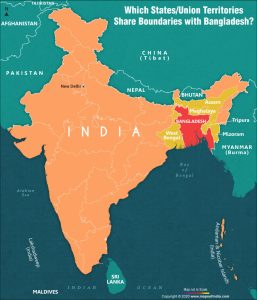26 Aug India – Bangladesh Relations
This article covers “Daily Current Affairs” and the topic details “India – Bangladesh Relations”. The topic “India – Bangladesh Relations” has relevance in the International Relations section of the UPSC CSE exam.
For Prelims:
About India – Bangladesh Relations?
For Mains:
GS 2: International Relations
Current Key Issues Between India and Bangladesh?
Way forward?
Why in the news:
The 14th Joint Group of Customs (JGC) meeting between India and Bangladesh was recently held in New Delhi.
These meetings of the India-Bangladesh Joint Group of Customs play a pivotal role in promoting cooperation concerning customs-related issues and further improving the facilitation of trade across the borders.
Major Outcomes of the 14th Joint General Cooperation (JGC) Meeting were as follows:
- Expansion of Land Customs Stations: The meeting focused on the establishment of new land customs stations, which play a vital role in facilitating cross-border trade.
- Bilateral Agreement on Customs Cooperation: Discussions explored the potential for a bilateral customs cooperation agreement, serving as a comprehensive framework for future collaborative efforts.
- Easing Port Restrictions: Deliberations centered on strategies to simplify port restrictions, enhancing overall port operational efficiency and reducing trade barriers.
- Operationalization of ACMP: India acknowledged Bangladesh’s successful trial runs and subsequent notification for operationalizing the Agreement on Use of Chattogram and Mongla Ports, as agreed upon in the previous JGC meeting.
- Electronic Connectivity of Transit Modules: Talks were initiated about electronically connecting the transit modules of ACMP, representing a significant stride toward efficient digital collaboration.
- Pre-Arrival Customs Data Exchange: Both sides engaged in discussions concerning the exchange of customs data before the arrival of goods. This initiative aims to expedite customs clearance by enabling authorities to prepare in advance.
About India – Bangladesh Relations:
- India was the first to recognize Bangladesh as a separate nation after its independence in December 1971 and established diplomatic relations right away.
- The bond between India and Bangladesh is based on shared civilization, culture, society, and economy.
- Bangladesh’s location as India’s eastern neighbor holds great strategic importance.
- This location provides India with access to the Bay of Bengal and a vital trade route to Southeast Asia.
Economic Partnership:
- Bangladesh stands as India’s biggest trading partner in South Asia. Notably, India’s exports to Bangladesh reached USD 8 billion between April and November 2022.
- India streamlined the movement of goods from its Inland Container Depots (ICDs) to Bangladesh using inland waterways.
- Additionally, a smoother process was established for transporting containerized exports from Bangladesh to other countries via India. This enhancement strengthens trade routes and brings forth new opportunities for moving goods.
- Since 2011, India has granted Bangladesh duty-free and quota-free access for all tariff categories, except for tobacco and alcohol, under the South Asian Free Trade Area (SAFTA) agreement.
- A noteworthy step occurred in July 2023 when Bangladesh and India initiated trade transactions using their own currencies. This move aims to reduce reliance on the US dollar, fostering stronger regional trade ties and currency dynamics.
Defense Collaboration:
- India and Bangladesh share a border that stretches for 4096.7 km, making it India’s longest land boundary with any neighboring country.
- The states of Assam, West Bengal, Mizoram, Meghalaya, and Tripura have shared borders with Bangladesh.
- Joint military exercises, namely Exercise Sampriti (Army) and Exercise Bongosagar (Navy), are conducted by the two nations.
Energy and Connectivity:
- The India-Bangladesh Friendship Pipeline, connecting Siliguri in West Bengal and Parbatipur in Dinajpur district of Bangladesh, is designed to transport one million Metric Tonnes Per Annum (MMTPA) of High-Speed Diesel into Bangladesh.
- Collaborative efforts extend to cross-border infrastructure projects like the Akhaura-Agartala rail link and Maitri Setu.
Multilateral Partnership:
- India and Bangladesh actively participate in regional collaboration through multilateral platforms like SAARC (South Asian Association for Regional Cooperation), BIMSTEC (Bay of Bengal Multi-Sectoral Technical and Economic Cooperation), and Indian Ocean Rim Association (IORA).

Current Key Issues Between India and Bangladesh:
Transboundary River Waters Sharing:
- India and Bangladesh share 54 common rivers, but only two treaties have been established: the Ganga Waters Treaty and The Kushiyara River Treaty.
- Negotiations are ongoing for major rivers like Teesta and Feni, leading to unresolved water-sharing disputes.
Illegal Migration:
- The challenge of illegal migration from Bangladesh to India involves refugees and economic migrants. This issue strains Indian border states, impacting resources and security, exacerbated by Rohingya refugees entering India via Bangladesh.
- Bangladesh has concerns regarding India’s National Register of Citizens (NRC) as it could affect bilateral relations.
Drug Smuggling & Trafficking:
- Cross-border incidents of drug smuggling and trafficking are a significant concern.
- The borders are used for trafficking humans, especially women and children, and for poaching various animal and bird species.
Chinese Influence in Bangladesh:
- Bangladesh’s active participation in China’s Belt and Road Initiative (BRI) contrasts with India’s non-involvement.
- China’s increasing presence in Bangladesh has the potential to challenge India’s regional influence and strategic goals.
Way forward:
Collaborative Law Enforcement Teams:
- Establishing joint task forces with representatives from law enforcement agencies in both nations is essential.
- Such teams can effectively counter cross-border drug smuggling and human trafficking by sharing information and executing synchronized operations.
Smart Border Management Approach:
- Embrace smart border management strategies employing artificial intelligence and data analytics.
- This approach harmonizes cross-border movements, guaranteeing both security and efficiency.
Creation of Digital Connectivity Corridor:
- Paving the way for a digital connectivity corridor linking the two countries is crucial.
- Concentrate on robust high-speed internet connections, digital services, and e-commerce platforms.
- This initiative can foster fresh channels for trade, collaboration, and the exchange of technological advancements.
SOURCE:https://pib.gov.in/PressReleaseIframePage.aspx?PRID=1951118
plutus ias current affairs eng med 26th August 2023
Q.1 Consider the following statements regarding India – Bangladesh Relations:
- Rohingyas are indigenous people of Bangladesh who cross illegally into the Indian states.
- India – Bangladesh are cooperating in preparing the National Register of Citizens (NRC) in India.
Which of the statements given above is/are correct?
(a) 1 only
(b) 2 only
(c) Both 1 and 2
(d) Neither 1 nor 2
ANSWER: D
Q.2 Consider the following statements regarding India – Bangladesh Relations:
- Water sharing treaties have been signed for major rivers like Teesta and Feni.
- Water sharing treaties have been signed for only two rivers between India & Bangladesh.
Which of the statements given above is/are correct?
(a) 1 only
(b) 2 only
(c) Both 1 and 2
(d) Neither 1 nor 2
ANSWER: B
Q.3 Discuss the evolving dynamics of the relationship between India and Bangladesh, focusing on key areas of cooperation and existing challenges.




No Comments